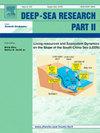罗斯海的海洋-大气-冰过程:综述
IF 3
3区 地球科学
Q2 OCEANOGRAPHY
Deep-sea Research Part Ii-topical Studies in Oceanography
Pub Date : 2024-10-11
DOI:10.1016/j.dsr2.2024.105429
引用次数: 0
摘要
自极地探索活动开始以来,罗斯海一直是广泛调查的地点。1957-58 国际地球物理年加强了研究活动,在该地区建立了科学站并收集海洋观测数据。虽然极地的海洋学、生态学、物理学、冰川学、地质学和生物地球化学的许多特征已为人所知,但最近的研究进展使人们对其结构和功能以及与全球气候的关系有了新的认识。我们全面回顾了在了解该地区发生的主要过程(如致密陆架水的形成和南极底层水(AABW)的产生)方面取得的进展,以及当地动态和水量变化的主要驱动因素(在大尺度和局部尺度上)。我们还总结了主要的建模应用,这些应用仍然有限,需要利用高分辨率模型和局部有限区域模型加以改进,以解释主要由热力学和水团转化驱动的过程。由于西段两个多旋流的活动,罗斯海形成了盐度最高的陆地断裂带。陆架上出现了盐度梯度,新鲜的低盐度陆架水集中在罗斯海东部,这是受阿蒙森海和贝林斯豪森海淡水流入的影响。这种淡水流入被认为是造成高盐度大陆架水(AABW 的前体)多年清新的原因,不过自 2014 年以来,已观察到罗斯海盐度回升。盐度的增加也影响了阿拉伯湾水的生成,而各自的反弹几乎同时发生。本文章由计算机程序翻译,如有差异,请以英文原文为准。
Ocean-atmosphere-ice processes in the Ross Sea: A review
The Ross Sea has been the site of extensive investigations since the earliest days of polar exploration. The International Geophysical Year of 1957-58 enhanced research activities with the establishment of scientific stations and the collection of oceanographic observations in the area. While many features of its oceanography, ecology, physics, glaciology, geology, and biogeochemistry are known, recent advances provide new insights into its structure and function, as well as into its relationship to global climate. We present a comprehensive review of the advances of understanding the main processes occurring in the area, such as the formation of dense shelf water and the production of Antarctic Bottom Water (AABW), as well as the main drivers (at both large and local scales) of local dynamics and water mass variability. We also summarize the main modeling applications, which are still limited and need to be improved using high-resolution models and, locally, limited-area models to explain processes driven mainly by thermodynamics and water-mass transformations. The Ross Sea forms the most saline AABW due to the activity of two polynyas in the western sector. A salinity gradient occurs on the shelf, with fresh Low Salinity Shelf Waters concentrated in the eastern Ross Sea, which is influenced by the inflow of fresh water from the Amundsen and Bellingshausen Seas. This freshwater inflow was thought to be the cause of a multi-decadal freshening of the High Salinity Shelf Water, precursor to the AABW, although a rebound in salinity in the Ross Sea has been observed since 2014. The increase in salinity has also affected the production of AABW, with the respective rebound occurring almost simultaneously.
求助全文
通过发布文献求助,成功后即可免费获取论文全文。
去求助
来源期刊
CiteScore
6.40
自引率
16.70%
发文量
115
审稿时长
3 months
期刊介绍:
Deep-Sea Research Part II: Topical Studies in Oceanography publishes topical issues from the many international and interdisciplinary projects which are undertaken in oceanography. Besides these special issues from projects, the journal publishes collections of papers presented at conferences. The special issues regularly have electronic annexes of non-text material (numerical data, images, images, video, etc.) which are published with the special issues in ScienceDirect. Deep-Sea Research Part II was split off as a separate journal devoted to topical issues in 1993. Its companion journal Deep-Sea Research Part I: Oceanographic Research Papers, publishes the regular research papers in this area.

 求助内容:
求助内容: 应助结果提醒方式:
应助结果提醒方式:


